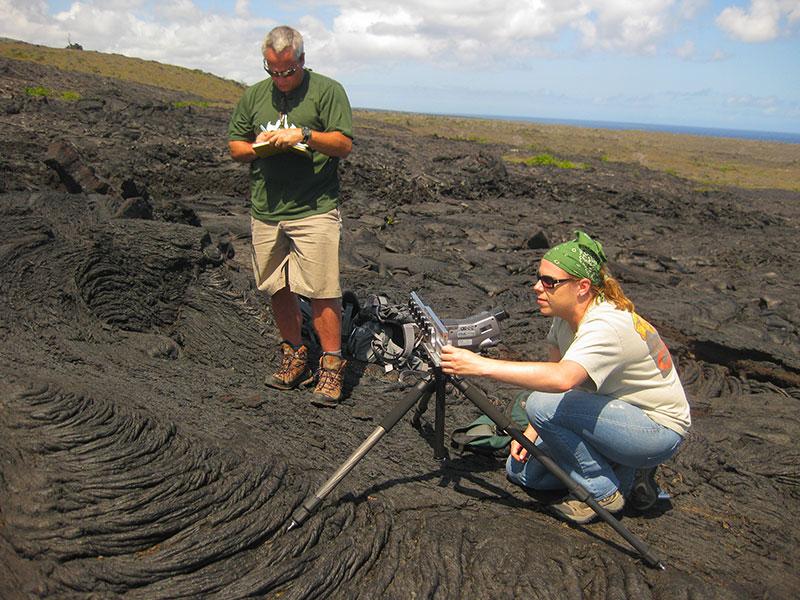Volcanic mission—Rachel Lee (right), now a member of SUNY Oswego’s atmospheric and geological sciences faculty, conducts research on lava flows from Mount Kilauea last summer on the island of Hawaii. Lee plane to use $30,000 in National Science Foundation funding for research supporting efforts to mitigate hazards to life and property posed by lava flows. (Photo by Michael Ramsey)
Rachel Lee of SUNY Oswego’s atmospheric and geological sciences department will research the behavior of lava flows on the island of Hawaii and in laboratory simulations, thanks to a highly competitive two-year, $30,000 grant from the National Science Foundation.
Working as co-investigator with colleagues from the University of Pittsburgh, where she earned a doctorate and did post-doctoral work, Lee will study the molten rock at temperatures exceeding 2000 degrees Fahrenheit to better predict the flows’ behavior as the lava cools. The overarching goal is to alleviate hazards through more accurate prediction.
Lee plans to do much of her data analysis at SUNY Oswego. She will involve undergraduates in that work and in experiments using thimble-size samples of lava. Larger scale lab work will take place at Pitt and at Syracuse University’s Lava Project. Other collaborators on the NSF project include researchers from Blaise Pascal University in France and the Hawaiian Volcano Observatory.
The fieldwork, likely next summer, will take place at lava flows on and around the Big Island’s Mount Kilauea, a volcano that has been erupting continuously since 1981. Researchers will study the properties and behavior of the flows using instruments that are handheld as well as satellite-based.
Kilauea’s relatively slow, basaltic flows have destroyed some 215 structures, including homes and buildings in Kalapana Gardens and Royal Gardens as well as the visitor center at Hawaii Volcanoes National Park. A recent threat to Pahoa in northeast Hawaii has abated for now, though low levels of seismic activity continue, according to the daily monitoring of the U.S. Geological Survey.
“Particularly from a hazard perspective, this (research) gives us a lot of information on where the lava may flow as it cools and how fast it may progress,” Lee said. “Ultimately, we hope to modify flow models to help mitigate hazards and loss of property.”
Advanced instruments
During work on her dissertation under Michal Ramsey at Pitt, Lee built a micro-furnace to study samples of lava as it cools to a glass. She plans to modify the Pitt-based device for the new grant, installing a fiber-optic camera to make continuous observations and a nitrogen-dry air gas flow to minimize oxidation.
The laboratory work informs and validates research data, but fieldwork is essential, Lee said. In Hawaii, she will use a multispectral infrared camera with filter attachments as well as data from the Advanced Spaceborne Thermal Emission and Reflection Radiometer aboard Terra, a NASA satellite.
As lava cools, it forms a thin crust, which gradually thickens to a glass. Lee will study temperature, crustal thickness, and flow direction and speed, along with variables such as elevation and air temperature.
She has observed lava flows around the world, as recently as this summer in Italy.
“It’s fascinating to me to see geological processes happening before your eyes,” said Lee, who started as a biochemistry and pre-med major in college but changed after a particularly enthralling geology class.
But the accuracy of the data gathered in scientific monitoring of volcanoes and lava flows is of more than scientific interest, she noted. “As more and more people live in these areas, it’s more and more important to understand these flows and to mitigate the hazards,” she said.




